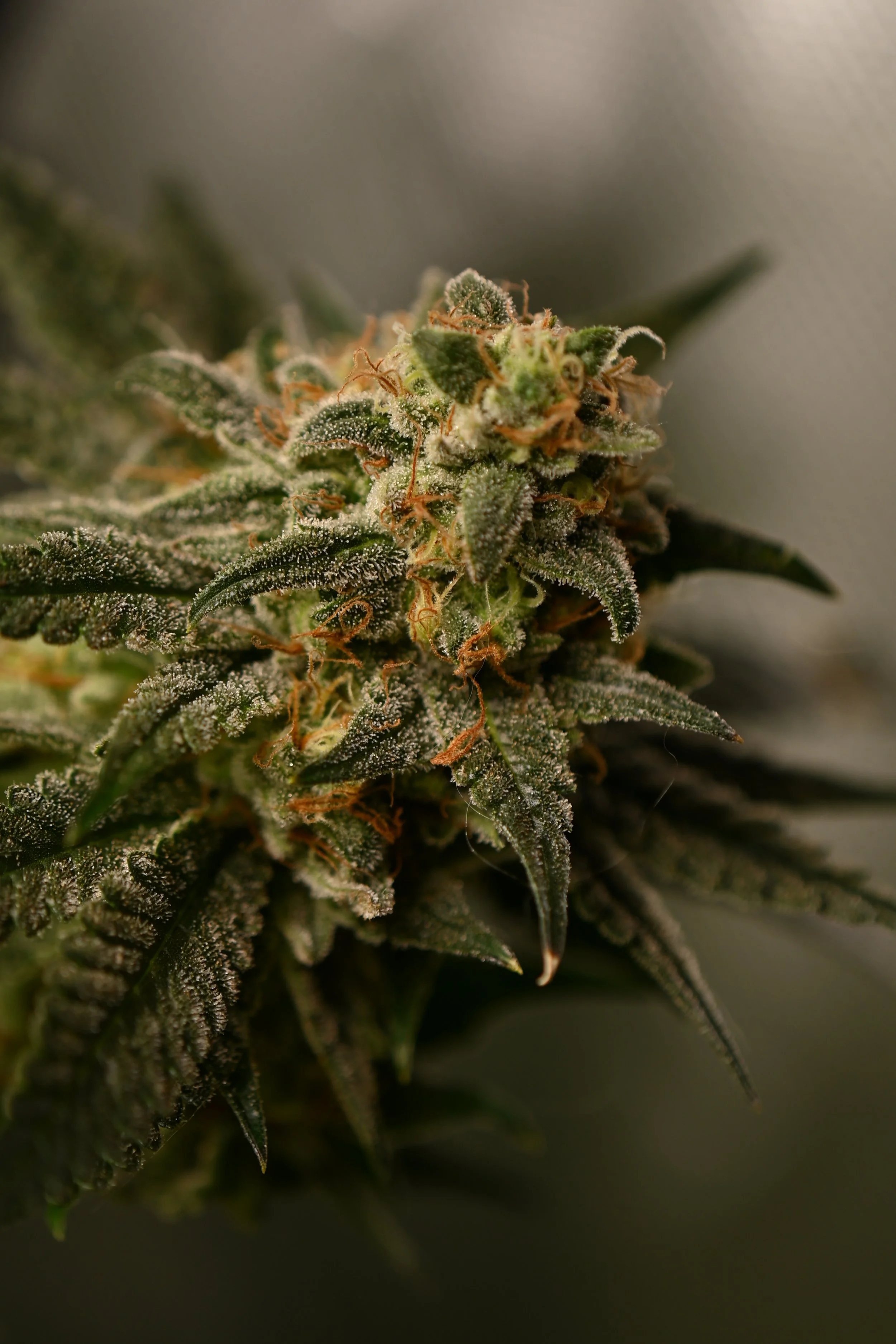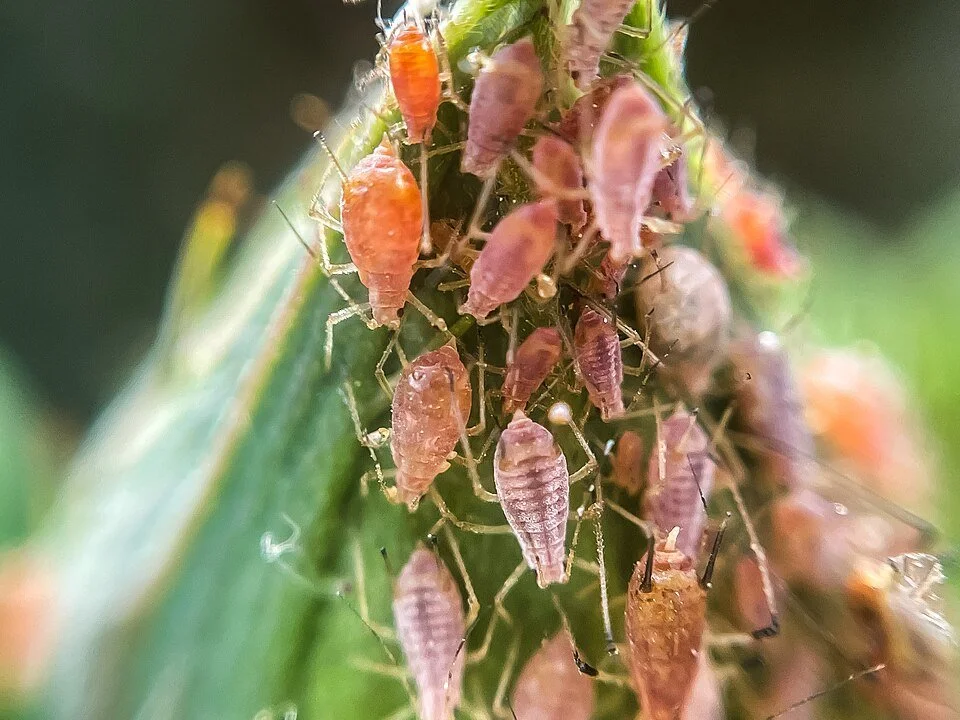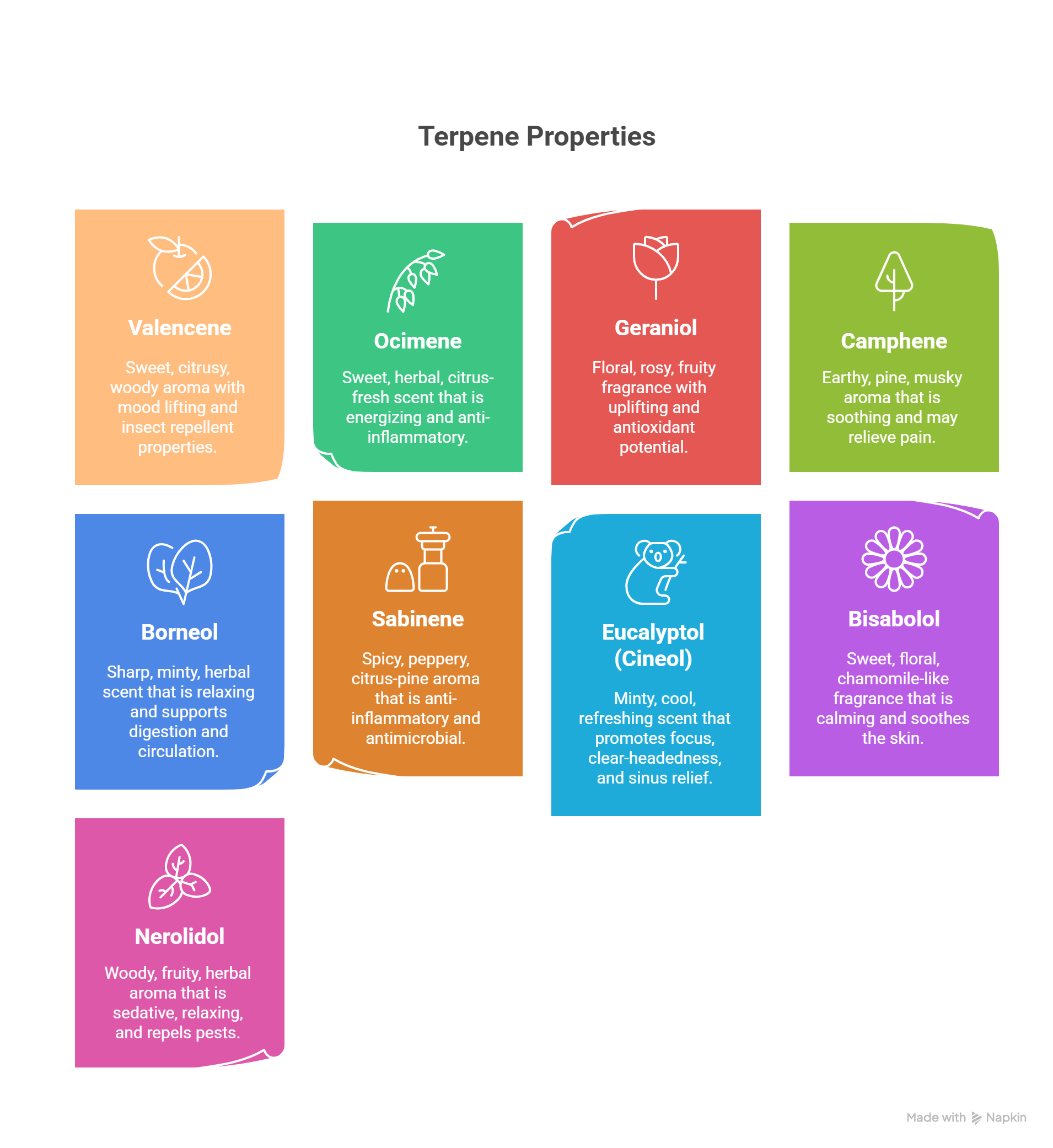Beyond THC : The Story of Secondary Terpenes
Close up of cannabis plant flower. Photo by Skyler Clawson
If you're a knowledgeable stoner, or you've ever chatted with our budtenders at Starbird, you’ve probably heard about terpenes. These aromatic compounds give cannabis its signature smell and flavor, and they play a huge role in how different strains make you feel.
Many people are familiar with the primary terpenes like limonene, myrcene, linalool, and caryophyllene — the big names that show up most often on lab results. But what about the hundreds of lesser-known terpenes that exist in smaller amounts?
These are called secondary terpenes, and while they may be present in trace percentages, they can still influence aroma, flavor, and effects in meaningful ways. Some repel pests, others help boost mood or reduce inflammation. Many fly under the radar, even on your labels, but they still help define what makes your favorite strain unique.
Let’s dig into these rare and underrated terpenes ; the ones that add complexity and character to your cannabis, even if you’ve never heard of them by name.
Why Does Cannabis Produce Terpenes?
Terpenes exist not only to produce nuanced and beautiful highs, but also to serve protective functions for plants. Some terpenes attract pollinators, like bees and hummingbirds. Other terpenes act as pest repellents. Limonene and pinene have been shown to repel insects with their strong aromas. Some also help deter herbivores from munching on the buds!
Some terpenes are even toxic to certain types of fungi and bacteria, which helps prevent decay and infections. So, the antifungal ability of carophyllene is for the plant first, and a beneficiary for us second.
Many terpenes develop terpenes to aid with stress tolerance. Some terpenes can help prevent stress caused by excessive heat, UV radiation and drought. Other terpenes help regulate the plant’s temperature and its retention of water. Linalool, for example, helps reduce oxidative stress resistance in cannabis leaves. When humans ingest it, we also absorb those relaxing and anti stress qualities. So, we have more similarities with cannabis plants than we think!
The most interesting capability of terpenes is their use of volatile organic compounds (VOCs). In essence, cannabis and other plants can use terpenes to communicate with each other. When a cannabis plant is under attack by pests or other predators, it can release terpenes into the air to warn nearby plants, so they can prepare to protect themselves. It’s nature’s own telephone, sounding the alarm for its fellow buds.
To be clear, cannabis plants don’t only produce one or two terpenes. Terpenes work in a synergy, and complex blends of them work harmoniously to repel attackers, attract allied species, manage environmental stress and damage, and communicate in a large network. This is why there is so much variance in terpenes. Each genetic makeup is specific to the needs of that particular plant.
Do Terpenes Get You High?
No, the psychoactive effects of cannabis primarily rely on THC, but that’s not the whole story. Terpenes work alongside THC, CBD, and other cannabinoids to shape the overall experience. This includes how strong the high feels, how long it lasts, and what kind of effects it produces. This synergy is known as the entourage effect.
If THC were the only compound that mattered, buying or growing cannabis would be simple. But in reality, cannabis is a chemically complex plant — and its effects come from the full spectrum of compounds working together, not just the THC percentage. That’s why two strains with identical THC levels can make you feel totally different.
What is the Difference Between Primary and Secondary Terpenes?
Primary terpenes are simply more abundant than secondary terpenes, which are often called minor terpenes. Terpenes like myrcene and limonene can appear in concentrations ranging from 0.1% to 2% or more. In contrast, secondary terpenes are typically present only in trace amounts, usually 0.05% or less. Because of their low concentrations, they're often omitted from Certificates of Analysis (COAs). Still, that doesn't mean they're unimportant.
Even in small amounts, secondary terpenes can meaningfully shape the aroma, flavor, and even the therapeutic nuances of a cannabis strain. Think of primary terpenes as the headline performers on tour, while the secondary terpenes are the backup dancers. Sure, everyone came to see the main act, but without the backup dancers, the show would lose its depth, excitement, and flair. They might not steal the spotlight, but they absolutely enhance the entire experience.
What Are Some Examples of Secondary Terpenes?
There are hundreds of terpenes that can be present in cannabis, so let’s give you the breakdown of the uncommon, yet amazing, minor terpenes found in your weed.
Valencene
Named after Valencia oranges, where it is found in high amounts. This terpene has a unique expression of sweet, woody and citrus aromas, and can also be found in fruits like lemons, tangerines and grapefruit. It can have anti-inflammatory properties, and is being researched for potential anti-allergy abilities. Valencene also has skin protectant abilities, and can be found in skincare and cosmetics due to this ability, coupled with its pleasant aroma. It is also a natural insecticide, and it is commonly found in mosquito and tick repellent.
Ocimene
Found in unique plants like kumquats, mint, orchid, and bergamot, Ocimene is a sweet, earthy and lightly citrus terpene. It provides a fresh taste to cannabis when it's found in higher amounts.
This terpene also has the ability to repel aphids, a sap sucking pest that can be detrimental to a cannabis plant’s health. Ocimene is also being studied for its anti-inflammatory and anti-oxidative properties, as well as potential benefits for stopping enzymes responsible for type 2 diabetes and hypertension.
Ocimene can be present in strains like the beloved Green Crack and Dutch Treat. Because of its vibrant aroma, Ocimene is also found commonly in perfumes and cologne.
Aphids on a Rosebud by merve.obekci, licensed under CC BY-SA 2.0.
Geraniol
This terpene is very floral, stemming from the essential oils of rose, lemongrass and of course, geraniums, where it gets its name from. It has a sweet, floral taste and aroma that is most closely associated with roses.
The benefits of this terpene are still being studied. However, it has shown to have the potential to reduce free radicals and cell damage. Its anti-inflammatory qualities are being researched for relief from conditions such as rheumatoid arthritis and IBS. It has also shown to possess uplifting and energizing effects when smoked in cannabis.
Geraniol has been found in higher contents in strains like Agent Orange and Purple Punch. Because of its iconic, sweet rosy smell, Geraniol is found commonly in perfumes, soaps, cosmetics , and even as flavoring for food and beverages.
Camphene
This terpene is recognized for its pungent, woodsy and pine like scent. Similarly to Pinene, this terpene is found in conifer trees like fir, cypress and camphor- where it draws its name from. It can also be found in herbs like sage and rosemary, or spices like nutmeg and ginger.
Camphene is highly flammable, and was used in lanterns and even fireworks. However, it is no longer used like this because its flammability posed many hazards. It was said that during the Bubonic Plague, people mixed camphene and rosewater to fumigate houses that were infested with bugs and rats.
This terpene can have soothing benefits when smelled, vaped or smoked, and many report it provides a happy mood boost. Studies show this terpene has strong potential for pain relieving and antiviral effects, and has also demonstrated soothing effects for coughs and congestion. You can find camphene present in topical treatments for pain relief. Due to its strong smell, you can’t mistake it!
Borneol
Another herbal terpene, with a similar aromatic profile to and camphene and similar benefits. It is present in plants like camphor, thyme, mint, sunflowers and rosemary. It has a sharp, mint and pine like smell that is very distinct.
Borneol has been used in traditional Chinese medicine for respiratory ailments. Today, it can be used to aid digestion, pain relief, improving blood circulation and lowering fevers. It can also act as an insect and parasite repellent. Scientists are studying Borneol’s potential to help with absorption of medicine for cancer patients, and has also been used as an anticoagulant for those who’s suffered from strokes. Borneol has shown to be present in higher amounts in strains like OG Kush, Sour Diesel and Amnesia Haze.
Sabinene
This is a terpene with a unique profile of pine, citrus and spice. Commonly found in black pepper, nutmeg, clove and juniper plants, and more prominently found in oak trees and spruces.
Sabinene is found quite rarely and is still in earlier stages of scientific research. It has shown positive results in dental studies, with the ability to protect against certain bacteria that cause tooth decay. Although there are not many results for how it contributes to your high, it has shown its potential use as a terpene that is anti inflammatory, antimicrobial, antifungal and antioxidant.
Eucalyptol
Guess what this one gets its name from? Yup! This terpene, also known as Cineol, is found in eucalyptus. It can also be found in sage, bay leaves and tea trees. It has an intense smell, often described as minty, clean and invigorating.
Eucalyptol is used commonly in aromatherapy, and has been applied for a multitude of ailments. Recipients of some studies reported pain relief and showed decreased blood pressure after using Eucalyptol. It has also shown beneficial results for sinus infections, and even elderly people struggling with dementia. Eucalyptol, when concentrated as an essential oil, is extremely flammable. You’ve probably been exposed to it through outdoor torches or candles, where it is used most often for its beautiful scent and ability to repel mosquitos.
Bottled eucalyptus oil on display — a natural source of the terpene eucalyptol.
Photo by Donaldytong, licensed under CC BY-SA 3.0.
Bisabolol
This rarer terpene has a delicate, sweet floral smell and taste. It is present in unique plants like German Chamomile and the Candeia tree, which is native to Brazil and where most of the terpene is extracted from.
Bisabolol is said to be the main ingredient that contributes to the calming and chill effects of chamomile tea, so having it present in cannabis can provide very relaxing highs. It can be found in many Kush strains. It has also shown great potential with its anti-inflammatory qualities, specifically with skin conditions and helping keep the epidermis moisturized.
Nerolidol
Often seen in Certificates of Analysis as trans-Nerolidol, this terpene has a layered profile of woody, fruity, and herbal notes. It can be found in lemongrass, jasmine, orange blossom and patchouli. Nerolidol functions in cannabis and other plants as a pest repellent, and also attracts pollinators. This terpene also attracts wasps that prey on insects like aphids, beetle larvae, and harmful caterpillars. Nerolidol is one of the terpenes produced to signal defense to other plants when under attack. This makes it extremely useful for outdoor grows, but isn’t needed as much in modern indoor hydroponic growing.
Nerolidol is being studied for its sedative properties and its ability to reduce anxiety. It is often found in higher amounts in strains like Skywalker OG and Jack Herer. Although it might be a less potent terpene, it can offer support when paired with more prevalent terpenes like linalool and myrcene. You can find nerolidol in natural pesticides, fragrances, flavoring. Due to its ability to help penetrate the skin, it is commonly used in topical applications for pain relief, like many other terpenes on this list.
A visual chart of secondary terpenes. Many aromas, tastes and effects have similarities.
Why Are Some Terpenes Less Common?
There are several reasons, but the biggest factor is genetics. Some cannabis plants simply don’t possess the genetic blueprint needed to produce high levels of rare terpenes like valencene or geraniol. If the terpene synthase genes aren’t present, or aren’t expressed, those terpenes will only appear in trace amounts, if at all.
Another major influence is the environment. A cannabis plant’s terpene profile is significantly affected by growing conditions such as temperature, light exposure, soil composition, nutrient availability, and stress levels. In fact, some uncommon terpenes are only produced when the plant experiences specific abiotic or biotic stressors. This range of factors can make terpene expression very different when grown by different cultivators, even if it's the same strain.
Modern selective breeding has also played a role in narrowing terpene diversity. For decades, breeders prioritized THC potency, yield, and popular aroma profiles like citrus and gas. These traits are driven by primary terpenes such as limonene, myrcene, and caryophyllene. As a result, less common terpenes like camphene, bisabolol, and valencene were unintentionally bred out or minimized.
Finally, lab testing limitations can make some terpenes appear absent. Many Certificates of Analysis (COAs) only report the top 3 to 5 terpenes, depending on the lab. This isn’t negligence, it’s simply because minor terpenes often fall below the detection threshold, even if they’re still present and contributing to the strain’s aroma and complexity
Is Shopping Based on Terpenes Better Than Shopping for THC?
Based on our philosophy, yes! As our budtenders often say, everything that gives a strain its properties, is everything but the THC. Jack Herer, for example, is said to be loved and sought after by many people. Yet, when we have this strain and it tests low, people shy away from it. It’s surprising how often people dismiss a great strain just because the THC is lower than they’d expect. Like many things in life, enjoying cannabis does need a bit of nuance. It's rare that one of our staff members will recommend a product solely based on high THC percentage. At Starbird, we deeply value the significance of the entourage effect. We gauge the quality of a strain based on its freshness, growing techniques, terpenes, cannabinoids, and ultimately, our firsthand experience.
Gauging the quality and effect of strains by terpenes is less understandable for many, because we have relied on THC percentage for years. However, think of it like aromatherapy. During meditations, someone might rub their hands with citrus oil for an uplifting effect. Many people light lavender candles at night to create a sleepy, calm environment. This is also because of terpenes. Not every cultivator is going to have a direct rundown of every single terpene present in the strain. However, you can gauge a lot about weed just by how it smells. The skunkier, muskier notes usually will have a more impactful body high. Herbal and floral aromas tend to be more relaxing and peaceful. Strains like Super Lemon Haze and Lemon OG are loved for their citrus and pine tastes, and normally produce stimulating highs. These aren’t necessarily exclusive, as terpenes can have all different expressions and make each strain unique.Cannabis is complex, so if you believe THC is the only thing that matters to your high, you might be surprised to see how much these terpenes seriously direct your buzz. As you may be able to tell, it’s not solely based on “Indica or Sativa” either.
If you sense a theme with which strains you like, or you find yourself drawn to specific profiles, narrowing down which terpenes you like can be extremely useful. It will help you while flipping through our large selection of buds. There are so many choices, it can seem overwhelming to pick the right one for you. However, our experienced budtenders at Starbird are more than happy to find what you’re looking for. When in doubt, communicate the effect or vibe you’re searching for. Each staff member’s choices will vary greatly if you’re smoking for a cozy night inside, or a lively daytime trip to the beach. We are professional weed smokers, and we will always select what works best for us so you can enjoy it too. There are no gatekeepers here!
Fly High!
FAQs: Rare & Secondary Cannabis Terpenes
What are secondary terpenes and why are they important?
Secondary terpenes are less abundant aromatic compounds in cannabis that still influence aroma, flavor, and effects. Even in trace amounts, they contribute to a strain’s complexity and can offer therapeutic benefits like anti-inflammatory or calming effects.
Do terpenes affect your cannabis high?
While terpenes don’t get you high on their own, they work with cannabinoids like THC and CBD to influence your experience. This synergy—known as the entourage effect—can affect how strong the high feels, its duration, and its character (e.g., uplifting vs. relaxing).
What are some examples of rare terpenes found in cannabis?
Examples of lesser-known terpenes include Valencene, Ocimene, Geraniol, Camphene, Borneol, Sabinene, Eucalyptol, Bisabolol, and Nerolidol. These terpenes can provide unique effects such as insect repellence, anti-inflammation, mood enhancement, or sedative properties.
Why are some terpenes less common in modern cannabis strains?
Genetics, growing conditions, stress exposure, and selective breeding have all influenced terpene expression. Breeders often prioritized high THC and popular primary terpenes, which led to lower levels of rare terpenes in many modern strains.
Is it better to shop for cannabis by terpenes instead of THC percentage?
Yes—terpenes offer a more accurate insight into how a strain will make you feel. At Starbird, we recommend focusing on terpene profiles, aroma, and personal experience rather than just chasing high THC numbers. Your best high might come from a balanced profile, not just potency.




